Helicopter
A helicopter is an aircraft which is lifted and propelled by one or more large horizontal rotors (propellers). Helicopters are classified as rotary-wing aircraft to distinguish them from conventional fixed-wing aircraft. The word helicopter is derived from the Greek words helix (spiral) and pteron (wing). The engine-driven helicopter was invented by the Slovak inventor Jan Bahyl. The first stable, fully-controllable helicopter placed in production was invented by Igor Sikorsky.
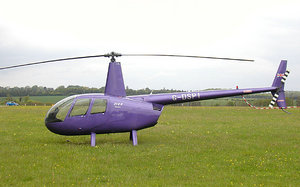
Compared to conventional fixed-wing aircraft, helicopters are much more complex, more expensive to buy and operate, relatively slow, have poor range and restricted payload. The compensating advantage is maneuverability: helicopters can hover in place, reverse, and above all take off and land vertically. Subject only to refuelling facilities and load/altitude limitations, a helicopter can travel to any location, and land anywhere with a clearing a rotor disk and a half in diameter.
Applications
Helicopters have many uses, both military and civil, including troop transportation, infantry support, firefighting, shipboard operations (http://www.tropicaled.com/helicopter2.htm), business transportation, casualty evacuation (including MEDEVAC, and air/sea/mountain rescue), police and civilian surveillance, carrying goods (some helicopters can carry slung loads, accommodating awkwardly shaped items), or as a mount for still, film or television cameras.
History
Since around 400 BC the Chinese had a flying top that was used as a children's toy. Incidentally, the Wright brothers were given this toy as kids and were very much fascinated by it. This toy eventually made its way to Europe via trade and it has been depicted in a 1463 painting. "Pao Phu Tau" was 4th century AD book in China that described some of the ideas in a rotary wing aircraft.
The first somewhat practical idea of a human carrying helicopter was first conceived by Leonardo da Vinci in the 15th century, but it was not until after the invention of the powered aeroplane in the 20th century that actual models were produced. Developers such as Jan Bahyl, Oszkár Asbóth, Louis Breguet, Paul Cornu, Juan de la Cierva, Emile Berliner, Ogneslav Kostovic Stepanovic and Igor Sikorsky pioneered this type of aircraft. A flight of the first fully controllable helicopter was demonstrated by Raúl Pateras de Pescara 1916 in Buenos Aires, Argentina. The Bell 47 designed by Arthur Young was the first helicopter to be licensed (in March 1946) for use in the United States.
Generating lift
A conventional aircraft is able to fly because the forward motion of its angled wings forces air downwards, creating an opposite reaction called lift that forces the wings upwards. A helicopter uses exactly the same method, except that instead of moving the entire aircraft, only the wings themselves are moved. The helicopter's rotor can simply be regarded as rotating wings.
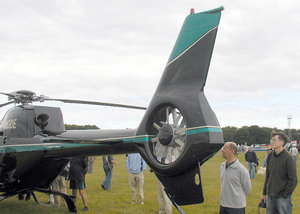
Turning the rotor generates lift but it also applies a reverse force to the vehicle, that would spin the helicopter in the opposite direction to the rotor. At low speeds, the most common way to counteract this torque is to have a smaller vertical propeller mounted at the rear of the aircraft called a tail rotor. This rotor creates thrust which is in the opposite direction from the torque generated by the main rotor. When the thrust from the tail rotor is sufficient to cancel out the torque fromt the main rotor, the helicopter will not rotate around the main rotor shaft.
If the tail rotor is shrouded (i.e., a fan embedded in the vertical tail) it is called a fenestron. A fenestron rotor uses a belt driven system to turn the fan and is less efficient, but less noisy than a traditional tail rotor. Other helicopters use a "Notar" design: they blow air through a long slot along the tail boom, utilizing the coanda effect to produce forces to counter the torque. Notar is an acronym meaning no tail rotor. Notars adjust thrust by opening and closing a sliding circular cover near the end of the tail boom.
Another alternative, which saves the weight of a tail boom and rotor but adds its own complexities, is to use two large horizontal rotors which turn in opposite directions. An example is the Boeing CH-47 Chinook or the Kamov Ka-50. All of these systems are designed for the same purpose: to produce a net rotational speed of zero.
The amount of power required to prevent a helicopter from spinning is significant. A tail rotor can use up to 30% of the engine's power, and this power does not help the helicopter produce lift or forward motion. To reduce this waste during cruise, the tailfin is angled to produce a sideways lift which helps counter the main rotor torque. At high speeds, it is common for the tailfin to counteract the entire torque, thus leaving more power available for forward flight. This is commonly known as slip-streaming and can occur while in a hover on windy days making hovering turns difficult.
Controlling flight
Useful flight requires that an aircraft be controlled in all three dimensions (see flight dynamics). In a fixed-wing aircraft, this is easy: small movable surfaces are adjusted to change the aircraft's shape so that the air rushing past pushes it in the desired direction. In a helicopter, however, there often isn't enough airspeed for this method to be practical.
For rotation about the vertical axis (yaw) the anti-torque system is used. Varying the pitch of the tail rotor alters the sideways thrust produced. Dual-rotor helicopters have a differential between the two rotor transmissions that can be adjusted by an electric or hydraulic motor to transmit differential torque and thus turn the helicopter. Yaw controls are usually operated with anti-torque pedals, on the floor in the same place as a fixed-wing aircraft's rudder pedals.
For pitch (tilting forward and back) or roll (tilting sideways) the angle of attack of the main rotor blades is altered or cycled during the rotation creating a differential of lift at different points of the rotary wing. More lift at the rear of the rotary wing will cause the aircraft to pitch forward, a increase on the left will cause a roll to the right and so on.
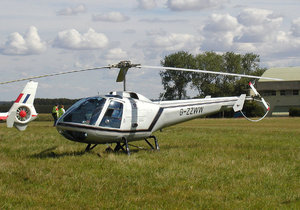
Helicopters maneuver with three flight controls besides the pedals. The collective pitch control lever controls the collective pitch, or angle of attack, of the helicopter blades together, that is, equally throughout the 360 degree plane-of-rotation of the main rotor system. When the angle of attack is increased, the blade produces more lift. The collective control is usually a lever at the pilot's left side, near his leg. Increasing the collective and adding power with throttle causes a helicopter to rise.
The throttle controls the absolute power produced by the engine that is connected to the rotor by a transmission. The throttle control is a twist grip on the collective control. RPM control is critical to proper operation for several reasons. Helicopter rotors are designed to operate at a specific RPM. If the RPM is too low, rapid descent with power, known as settling with power could result. If the RPM is too high, damage to the main rotor hub from excessive forces could result. In general, RPM must be maintained within a tight tolerance, usually a few percent. In many piston-powered helicopters, the pilot must manage the engine and rotor RPM. The pilot manipulates the throttle to maintain rotor RPM and therefore regulates the effect of drag on the rotor system. Turbine engined helicopters, and some piston helicopters, use servo-feedback loop in their engine controls to maintain rotor RPM and relieves the pilot of routine responsibility for that task.
The cyclic changes the pitch of the blades cyclically, causing the lift to vary across the plane of the rotor disk. This is how the pilot causes the aircraft to tilt, and the helicopter to move. The cyclic is usually controlled by the stick in front of the pilot.
As a helicopter moves forward, the rotor blades on one side move at rotor tip speed plus the aircraft speed and is called the advancing blade. As the blade swings to the other side of the helicopter, it moves at rotor tip speed minus aircraft speed and is called the retreating blade. To compensate for the added lift on the advancing blade and the decreased lift on the retreating blade— lift being a function of an airfoil's angle of attack and its relative airspeed— the angle of attack of the blades is regulated by the geometry of the rotor blade control system and mechanisms that allow the blades to flap up and down. This fact of advancing and retreating blades defines the speed limitations of the helicopter.
If the angle of attack of any wing, including rotor blades, is too high, the airflow above the wing separates causing instant loss of lift and increase in drag. This condition is called aerodynamic stall. On a helicopter, this can happen in any of three ways.
- As helicopter speed increases, the advancing blades approach the speed of sound and generate shock waves that disrupt the airflow over the blade causing loss of lift.
- As helicopter speeds increase, the retreating blade experiences lower relative airspeeds and the controls compensate with higher angle of attack. With a low enough relative airspeed and a high enough angle of attack, aerodynamic stall is inevitable. This is called retreating blade stall.
- Any low rotor RPM flight condition accompanied by increasing collective pitch application will cause aerodynamic stall.
Helicopters are powered aircraft, but they can still fly without power by using the momentum in the rotors and using downward motion to force air through the rotors. The rotors act like a "windmill" and turn. This technique is known as autorotation, and will give the helicopter crew a few precious seconds to quickly find a landing spot if its engine fails.
Helicopters are always designed so that even if the engines fail, autorotation will power the tail rotor or torque differential. Helicopters retain all flight controls when unpowered.
A very peculiar feature of the cyclic is that the lift is made to occur 90 degrees of rotation before the direction of tilt. This is because when one tries to tilt a spinning object (like a rotor), it moves at right angles to the direction of the force. This is called "gyroscopic precession". So control forces on the rotor are rotated 90 degrees before the desired motion. For example, forward motion requires less lift at the front of the disk and more lift at the rear of the disk, so the pilot pushes the cyclic forward. The helicopter's control linkages rotate the pitching forces 90 degrees backwards against the rotor spin, to push on the sides of the rotor rather than its front and back.
It took inventors many years to recognize precession, and to learn how to arrange the cyclic's control system to overcome it.
Limitations of rotary-wing flight
The single most obvious limitation of the helicopter is its slow speed. The current record is around 400km/h set by the Westland Lynx. There are several reasons why a helicopter cannot fly as fast as a fixed wing aircraft.
- When the helicopter is at rest, the outer tips of the rotor travel at a speed determined by the length of the blade and the RPM. In a moving helicopter, however, the speed of the blades relative to the air depends on the speed of the helicopter, as well as on their rotational velocity. The airspeed of the forward-going rotor blade is much higher than that the helicopter itself. It is possible for this blade to exceed the speed of sound, and thus produce vastly increased drag and vibration. It is theoretically possible to have spiralling rotors, similar in principle to variable-pitch swept wings, which could exceed the speed of sound, but no presently known materials are light enough, strong enough, and flexible enough to construct them.
- Most rotors are not rigid. Because the advancing blade has higher airspeed than the retreating blade, a perfectly rigid blade would generate more lift on that side and tip the aircraft over. In consequence, rotor blades are designed to "flap" - lift and twist in such a way that the advancing blade flaps up and develops a smaller angle of attack, thus producing less lift than a rigid blade would. Conversely, the retreating blade flaps down, develops a higher angle of attack, and generates more lift. At high speeds, the force on the rotors is such that they "flap" excessively and the retreating blade can reach too high an angle and stall. In some designs the hub is rigid. The blades are made from composites which can bend without breaking. Fully rigid rotors exist and create very responsive helicopters. In most such designs, the lift is varied cyclically and according to the speed of the helicopter. The adjustment is either by adjusting the angle of attack of the blades, or by engine-powered vacuum devices that suck air into the blades, adjusting the lift.
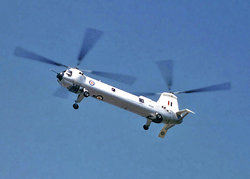
- Rotorhead design is a limiting factor on many helicopters. Low or negative-G situations encountered in a semi-rigid system will result in blade flapping down until it hits the tail boom or other airframe structure, followed by rotor separation and catastrophic terrain impact.
- Helicopters are susceptible to potentially disastrous vortex ring effects. In these, the downward wind from the rotor causes a circular vortex to form around the rotor. If this ring is augmented by terrain, wind, rain, or sea spray, the helicopter can lose enough lift to have settling with power and hit the ground.
During the closing years of the 20th century designers began working on helicopter noise reduction. Urban communities have often expressed great dislike of noisy aircraft, and police and passenger helicopters can be unpopular. The redesigns followed the closure of some city heliports and government action to constrain flight paths in national parks and other places of natural beauty.
Helicopters vibrate. An unadjusted helicopter can easily vibrate so much that it will shake itself apart. To reduce vibration, all helicopters have rotor adjustments for height and pitch. Most also have vibration dampers for height and pitch. Some also use mechanical feedback systems to sense and counter vibration. Usually the feedback system uses a mass as a "stable reference" and a linkage from the mass operates a flap to adjust the rotor's angle of attack to counter the vibration. Adjustment is difficult in part because measurement of the vibration is hard. The most common adjustment measurement system is to use a stroboscopic flash lamp, and observe painted markings or coloured reflectors on the underside of the rotor blades. The traditional low-tech system is to mount coloured chalk on the rotor tips, and see how they mark a linen sheet.
Landing
On a ship
A helo deck is a helicopter pad on the deck of a ship, usually located on the stern and always clear of obstacles that would prove hazardous to a helicopter landing. In the U.S. Navy it is commonly and properly referred to as the flight deck. Shipboard landing for some helicopters is assisted though use of a haul-down device that involves attachment of a cable to a probe on the bottom of the aircraft prior to landing. Tension is maintained on the cable as the helicopter descends which assists the pilot with accurate positioning of the aircraft on the deck; once on deck locking beams close on the probe, locking the aircraft to the flight deck. This device was pioneered by the Royal Canadian Navy and was called "Beartrap". The U.S. Navy implementation of this device, based on Beartrap, is called the "RAST" system (for Recovery Assist, Secure and Traverse) and is an integral part of the LAMPS MK III (SH-60B) weapons system.
Hazards of helicopter flight
As with any moving vehicle, operation outside of safe regimes could result in loss of control, structural damage, or fatality. For helicopters the hazards are particularly acute since they are flying at relatively low altitude, with little time to react to a sudden event. The following is a list of some of the potential hazards:
- Retreating blade stall
- Settling with power
- Ground resonance
- Low-G condition
- Operating within the shaded area of the height-velocity diagram
Each of these conditions is potentially fatal and recovery might not be possible. For this reason, good pilotage demands operation within safe flight regimes and avoiding hazardous conditions at all costs.
Helicopter models and identification
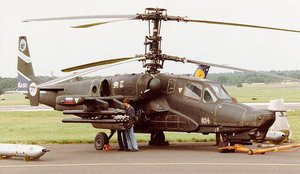
In identifying conventional helicopters during flight it is helpful to know that when viewed from below, the rotor of a French, Russian, Soviet or Ukrainian designed helicopter rotates anti-clockwise, whilst that of a helicopter built in Italy, the UK or the USA rotates clockwise (see list of helicopter models).
Some companies, notably Schweizer in the USA, are developing remotely-controlled variants of light helicopters for use in future battlefields.
Hybrid types that combine features of helicopters and fixed wing designs include the experimental Fairey Rotodyne of the 1950s and the Bell Boeing Osprey, which is on order by the US Marine Corps and is the first mass produced tilt-rotor aircraft to enter service.
A helicopter should not be mistaken for an autogyro, which is a historical predecessor of the helicopter that gains lift from an unpowered rotor.
Some common nicknames for helicopters are "copter", "chopper", "whirlybird", "helo" (common U.S. Navy usage) or "paraffin budgie" (the latter term being mostly used in the UK offshore oil industry).
External links
- U.S. Patent 1848389) : "Aircraft, especially aircraft of the direct lift amphibian type and means of construction and operating the same "
- History of helicopters (http://centennialofflight.com/history/helicopter.html)
- Page containing an image of a Chinese flying top (http://www.aerospaceweb.org/design/helicopter/history.shtml)
- Helicopter development in the early 20th century (http://www.centennialofflight.gov/essay/Rotary/early_20th_century/HE2.htm)
- Description of a helicopter (http://www.centennialofflight.gov/essay/Dictionary/helicopter/DI27.htm)
